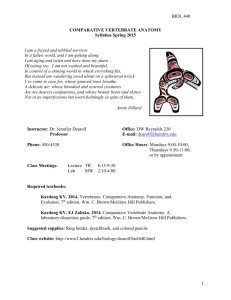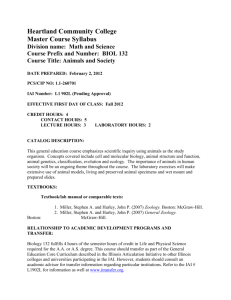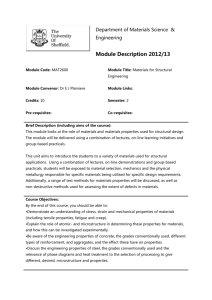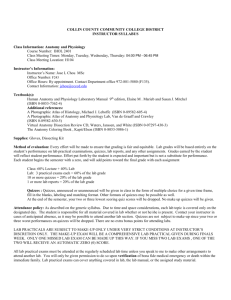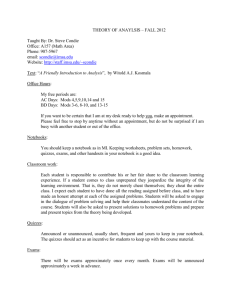zool 321 musser - Western Illinois University
advertisement
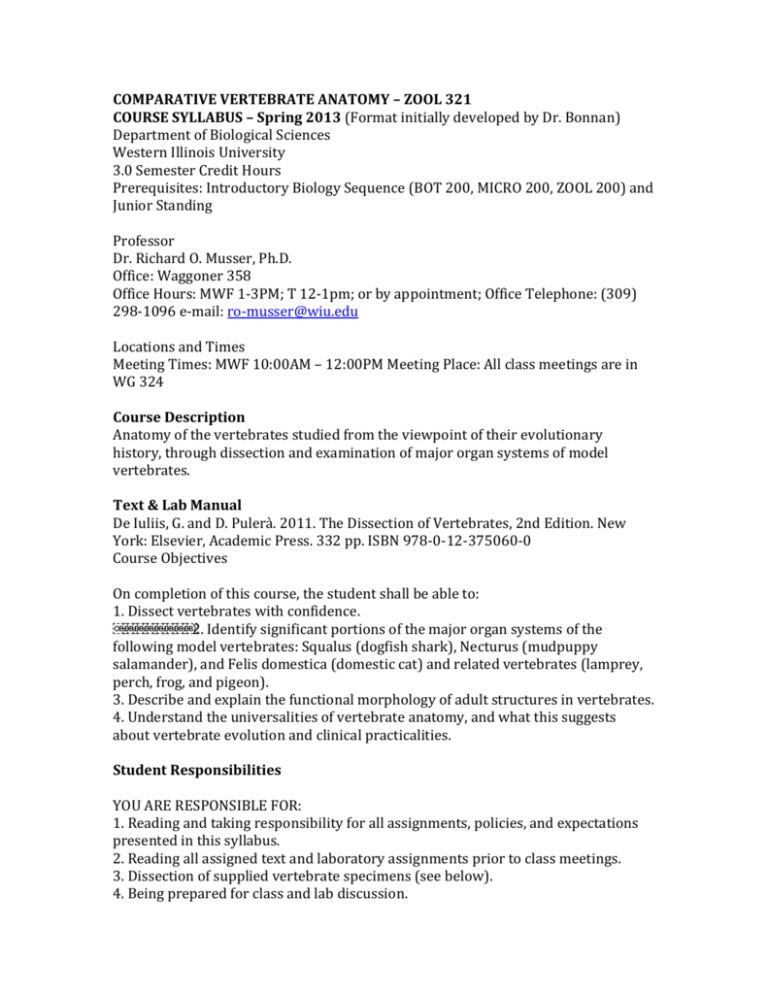
COMPARATIVE VERTEBRATE ANATOMY – ZOOL 321 COURSE SYLLABUS – Spring 2013 (Format initially developed by Dr. Bonnan) Department of Biological Sciences Western Illinois University 3.0 Semester Credit Hours Prerequisites: Introductory Biology Sequence (BOT 200, MICRO 200, ZOOL 200) and Junior Standing Professor Dr. Richard O. Musser, Ph.D. Office: Waggoner 358 Office Hours: MWF 1-3PM; T 12-1pm; or by appointment; Office Telephone: (309) 298-1096 e-mail: ro-musser@wiu.edu Locations and Times Meeting Times: MWF 10:00AM – 12:00PM Meeting Place: All class meetings are in WG 324 Course Description Anatomy of the vertebrates studied from the viewpoint of their evolutionary history, through dissection and examination of major organ systems of model vertebrates. Text & Lab Manual De Iuliis, G. and D. Pulerà . 2011. The Dissection of Vertebrates, 2nd Edition. New York: Elsevier, Academic Press. 332 pp. ISBN 978-0-12-375060-0 Course Objectives On completion of this course, the student shall be able to: 1. Dissect vertebrates with confidence. 2. Identify significant portions of the major organ systems of the following model vertebrates: Squalus (dogfish shark), Necturus (mudpuppy salamander), and Felis domestica (domestic cat) and related vertebrates (lamprey, perch, frog, and pigeon). 3. Describe and explain the functional morphology of adult structures in vertebrates. 4. Understand the universalities of vertebrate anatomy, and what this suggests about vertebrate evolution and clinical practicalities. Student Responsibilities YOU ARE RESPONSIBLE FOR: 1. Reading and taking responsibility for all assignments, policies, and expectations presented in this syllabus. 2. Reading all assigned text and laboratory assignments prior to class meetings. 3. Dissection of supplied vertebrate specimens (see below). 4. Being prepared for class and lab discussion. 5. Being polite to other students and the professor by showing up on time for lecture and lab, and by keeping cell phones turned off during class. 6. Having access to university computers for downloading lecture goals, course information and handouts, and taking the on-line exams and submitting the applied problems. 7. All material covered during class meetings, including additional material not covered in your text, lab manual, or in the Reader. 8. Taking exams and vocabulary quizzes on the days they are given. 9. Completing assignments by their due dates. 10. Keeping track of your own grade. Materials You Will Need For This Course You are expected to purchase a dissection kit that includes the following items (you can purchase such a kit in the bookstore; ask me for details): A small and large scalpel – for different “coarseness” of dissection: blade sizes of 21 and 10 or 11 are best. Dissection scissors – a tool we will use more often than scalpels A mall probe – helps to separate out muscle bellies Safety glasses – I cannot allow anyone to dissect without safety glasses. Specimens are wet and splashes are common. We begin working with wet specimens the second week of class and you should have glasses by then. Prescription glasses are acceptable substitutes for safety glasses. Closed-toed shoes – no one will be allowed into lab without closed-toed shoes. Dissection clothes – either dirty/old clothes you don’t mind getting preservative on, or a lab coat. I strongly recommend a lab coat. You must wear long pants in lab, no exceptions. You must purchase a package of note cards for vocabulary quizzes. Contact Lenses You should not wear contact lenses to lab – the preservative will permeate the lenses and can cause eye irritation. If you do not have a pair, you will want to obtain prescription glasses for lab. As stated above, these can also be used as safety glasses.  Statement on Dissection Do not take this course if you are unwilling, for any reason, to dissect. Dissections of vertebrates are required for this course, and no student will be excused from the laboratory portion of the course. Please recognize that there are no alternative activities that will give you in-depth knowledge of all the vertebrates we will examine in this course, or that will adequately prepare you for exams, lab practicals, or future courses where you may be expected to apply this knowledge (e.g., medical, veterinary careers, animal research, etc.). For example, there are currently no university-level computer dissection programs of sharks and salamanders, and plastic models cannot adequately convey anatomy for comparative purposes. Hands-on dissection of vertebrates is the best possible method for coming away with a long-lasting understanding of anatomy and its application in future studies. If you discover that you are incapable of dissecting and cannot participate in lab this way, please withdraw from the course in time to receive a full refund: http://www.wiu.edu/registrar/refunds.php Attendance Attending class meetings in a course such as this is critical to your understanding of complex anatomical material. You are all adults and I will not track your attendance. However, your performance in this course will be adversely affected if you do not show up regularly. Students with poor attendance always and without exception do very poorly in this course. I do not supply notes to students who missed class. Spring Break Notice: According to the university, Spring Break begins on Monday, March 12, 2012, and classes resume Monday, March 19, 2012. Exams, quizzes, or other activities missed because you are leaving early or returning late for vacation purposes cannot be made up. Please Note: When you registered for this course, you understood and agreed to attend the course at the time and days it met. I am not your personal secretary – it is up to you, not me, to ensure you can attend class and labs. It is important to recognize that this is not a distance course and you are expected to attend and participate. Success in this course depends on how well you integrate the outside readings and apply this knowledge in lab. To help you succeed, I provide a series of on-line materials available at the course homepage and on WesternOnline. The exams and copies of handouts in this course are available on-line via WesternOnline. You must become familiar with the WesternOnline site. Although Dr. Bonnan posts exams, etc., to WesternOnline, he is not a WesternOnline programmer. Therefore, if you have questions or problems regarding the functions of WesternOnline, contact one of the Academic Computing Resource Centers on Campus. These are located in the student union and Stipes 126. Directions for accessing course material on WesternOnline are published at: http://westernonline.wiu.edu/  How to read for this course. 1. First, consult the syllabus to see the assigned readings for a given class meeting. 2. Before you read, go to the on-line Questions & Goals either through the class webpage or through WebCT. Read these questions first, then read the lab manual pages assigned for that class meeting. This will help you tremendously in finding what is important for that day. 3. I stress: always read the lab manual pages first. 4. Next, consult the assigned chapter from the Comparative Anatomy Reader, available online via WebCT. This Reader gives pertinent information on aspects of anatomy relevant to the day’s dissection. 5. After attending class for the day, consult the Reader and lab manual to review material dissected and discussed in lab. This syllabus has a detailed calendar with readings of the lab manual (Dissection of Vertebrates) and Reader. Please be aware: these on-line materials are no substitute for attending class. All students are responsible for all material covered in lecture and lab, including material not covered in the text or on-line goals. Academic Dishonesty At Western Illinois University, cheating is a violation of official university policy. Cheating, plagiarism, and other forms of academic dishonesty will not be tolerated in this course. Should you have any doubt as to what constitutes academic dishonesty, please consult the Official University Policy (http://www.wiu.edu/policies/acintegrity.php). Ignorance of university policies on academic dishonesty does not exempt a student from the penalties. Students will be held to Official University Policy in relation to these matters, and are responsible for understanding and following it. If the need for a grade appeal arises, we will follow university procedure: http://www.wiu.edu/policies/acintegrity.php#rnthree Statement on Cheating & Plagiarism Cheating and plagiarism will not be tolerated in this course. Copying another student’s quiz, exam, or lab practical, or other course activities, or collaborating with one or more students to cheat on quizzes, exams, lab practicals, or other course activities will result in the following penalties: First offense: zero for the quiz, exam, lab practical, or other graded activity; report to CAGAS. Second offense: failure of the course and academic dishonesty related discipline. 4 Plagiarism is considered especially egregious and will result in failure of the assignment in which it occurs. If plagiarism occurs a second time, failure of the course and academic dishonesty related discipline will follow. Course Grading Lecture Examinations 150 Points All students will take four (4) lecture examinations worth 50 points each, and a semi- cumulative final exam worth 100 points (50 points from new material, 50 points from previous material throughout the semester). These exams will be given on WebCT. Each exam will consist of a combination of multiple-choice, diagram identification, and matching questions that are based on the reading assignments, lab activities, and material presented in class. This includes presented material not available in the books or on-line materials! It is every student’s responsibility to be prepared for these exams by attending lecture. It is also every student’s responsibility to find out what they missed during lectures for which they were absent. The lowest of the first four exam scores will be dropped. Therefore, your score for the first four exams will correspond to the best three of four. The final exam is required of all students. Students cannot skip or miss this exam for any reason except extended hospital stay (two or more days in the hospital) or death in the immediate family. Appropriate documentation is required for an excuse to be valid, and a different exam must be taken by the student within one week of the final exam. The make-up final exam will be written and include essays. Exam Procedures All lecture exams (including the final) will be given through the WesternOnline site for our course. Each exam will be posted to WesternOnline for 48 hours at times specified by Dr. Bonnan throughout the semester. The questions are randomized and each student will receive a randomly selected set of questions. The exams are open book and open note, but you will only have 90 minutes to complete them; 2 hours will be given for the final exam. When you submit your exam, it will be graded and returned to you via WesternOnline – please allow at least one week for grading and results to be posted.  Lab Practicals 500 Points Five (5) major lab practicals worth 100 points each will be given during the course of the semester. Lab practicals are fill-in-the-blank format, and will consist of 50 questions and 2 or more bonus questions. There is no such thing as a word bank – don’t ask for one. Missed Exams Policy On-line Exams: The first four on-line exams cannot be made up for any reason. This is because you can drop your lowest exam grade for the first four. Lab Practicals: Although the lowest grade of the first four lab practicals will be dropped, all students must take all lab practicals. If you miss one of the first four lab practicals, it is your responsibility to contact Dr. Bonnan and arrange to make it up within one week from the lab practical date. The make-up lab practical will always be more difficult and have fewer questions – do whatever you can not to miss a lab practical. VERY IMPORTANT: If you miss the final exam or a lab practical, you will automatically fail this course. Students cannot skip or miss the final exam or any lab practical for any reason except extended hospital stay (two or more days in the hospital) or death in the immediate family. Appropriate documentation is required for an excuse to be valid, and a different exam must be taken by the student within one week of the final lab practical. Show up on time for lab practicals! You will not be given extra time if you show up late. The final exam is an on-line exam – it will be posted on Monday, May 7, 2012 and be available for taking until 11:59 PM on Wednesday, May 9, 2012. Vocabulary-of-the-Day Quizzes 100 Points Approximately 25 Vocabulary-of-the-Day quizzes will be given throughout the course of the semester worth 5 points each. Each quiz will be given by Dr. Bonnan at the beginning of most class meetings – students will write out an anatomical word with correct spelling and write a short statement about its anatomical importance. Points are assigned based on spelling (2) and content (3). The top twenty vocabulary quiz scores will be totaled for your quiz grade at the end of the semester (20 X 5 = 100). All other quizzes will be dropped. Missed quizzes cannot be made up for any reason. 6 Comparative Vertebrate Anatomy, ZOOL 321, Syllabus, Bonnan Spring 2012 Applied Problems 150 Points Six applied problems worth 30 points each will be presented throughout the semester, given after each lab practical, including the final lab practical. Each problem will involve the application of class material to a specific problem encountered in vertebrate animals. These problems ask an open-ended anatomical or functional morphology question that requires students to draw on their knowledge of particular organ systems. The problems will be posted on WesternOnline the week of a given exam. Students will submit their essay via WesternOnline through the Safe Assign feature. Students will have a block of ~30 minutes to answer the question(s), so they should prepare by doing appropriate “research” on the posted problem. These problems are specific and require an in-depth response from each student. As per university policy, plagiarism in all its forms will not be tolerated. At the end of the semester, the lowest applied problem of the six will be dropped. Missed applied problems cannot be made-up for any reason. Grading rubric for Applied Problems: Summary (10) Grammar (10) Spelling & Terminology (10) Major points addressed, comprehensive understanding demonstrated [10] Appropriate grammar for a university-level science essay [10] Proper spelling and terminology for a university- level anatomy essay [10] One or more major points not addressed [5] One or more grammatical errors [5] One or more spelling or terminology errors [5] No major points addressed [0] Three or more grammatical errors [0] Three or more spelling or terminology errors [0]  Dissection Warning Your shark, mudpuppy, and cat specimens are used in the lab practicals. Therefore, it is important that you keep up with the required dissections. The names of you and your lab partner will be next to your specimen during lab practicals. I select specimens for the exam at random – therefore, if your specimen is poorly dissected this is what will be shown on the exam. Keep up with dissections and do a good job!  How Grades Are Determined 3 of 4 Lecture Exams 1 Final Exam 20 Highest Marked Vocabulary Quizzes 5 of 6 Applied Problems 5 Lab Practicals (see above) Total Points Grading Scale I do not grade on a curve. 90-100% A 900-1000 88-89% A- 880-899 = 150 Points = 100 Points = 100 Points = 150 Points = 500 Points =1000 Points 15% of grade 10% of grade 10% of grade 15% of grade 50% of grade 100% of grade  86-87% B+ 82-85% B 80-81% B- 78-79% C+ 72-77% C 70-71% C- 68-69% D+ 6267% D 60-61% D- 00-59% F Extra Credit 860-879 820-859 800-819 780-799 720-779 700-719 680-699 620-679 600-619 000-599 You have the opportunity to earn 1000 points in this course from a wide variety of activities (exams, quizzes, lab practicals, lab participation) spread over the semester. Therefore, I will not offer extra credit assignments – the grade you earn corresponds to the points you accumulate. Please do not ask for extra credit assignments – none will be given. Students with Disabilities “In accordance with University policy and the Americans with Disabilities Act (ADA), academic accommodations may be made for any student who notifies the instructor of the need for an accommodation. It is imperative that you take the initiative to bring such needs to the instructor’s attention, as he/she is not legally permitted to inquire about such particular needs of students. Students who may require special assistance in emergency evacuations (i.e., fire, tornado, etc.) should contact the instructor as to the most appropriate procedures to follow in such an emergency. Contact Disability Support Services at 298-2512 for additional services.” See also: http://dss.wiu.edu/
